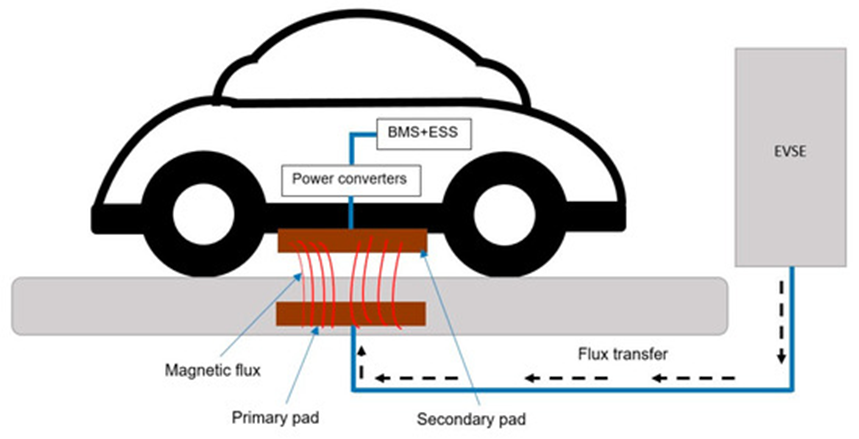Design Methodology and Circuit Analysis of Wireless Power Transfer Systems Applied to Electric Vehicles Wireless Chargers
The authors propose a design methodology for a serial–serial (SS) wireless system, which outlines how to determine the appropriate pad dimensions for transferring power to the EV battery.

Figure 1. The concept of a static WPT charger.
In road transportation, the market for electric vehicles (EVs) is considered a potential solution for addressing issues related to gas emissions and noise pollution. Due to the limited driving range of the EV battery pack, the charging process must be fast and safe for EV drivers. Wireless charging technology for EVs has gained attention in recent years, and in this research, the authors explore the analysis and design of a resonant magnetic wireless system for charging electric vehicles. The authors propose a design methodology for a serial–serial (SS) wireless system, which outlines how to determine the appropriate pad dimensions for transferring power to the EV battery. The design approach is crucial to attaining the best possible coupling performance and efficiency. Additionally, the magnetic design of the pad is validated using Ansys Maxwell software, and the proposed design is co-simulated using Ansys Simplorer to analyze the performance of the system. Simulation results demonstrate that the proposed model can transfer over 3.7 kW of power with an efficiency of over 90.02%. The paper also discusses the bifurcation phenomenon at the resonance condition to ensure maximum efficiency.
Authors: Tasnime Bouanou, Hassan El Fadil, Abdellah Lassioui, Issam Bentalhik, Mohamed Koundi, and Sidina El Jeilani
In the same category
- A Smart Battery Management System for Electric Vehicles Using Deep Learning-Based Sensor Fault Detection
- Autel Energy Europe at AEC 2024: Pioneering the Future of Ultra-Fast EV Charging
- Baden-Württemberg International: Your partner for a successful expansion
- Business Region Goteborg : Gothenburg - Pioneering tomorrow's mobility
- Charging Electric Vehicles Today and in the Future
- Comparative Study of Permanent Magnet, Conventional, and Advanced Induction Machines for Traction Applications
- Design Methodology and Circuit Analysis of Wireless Power Transfer Systems Applied to Electric Vehicles Wireless Chargers
- Designing High-Power-Density Electric Motors for Electric Vehicles with Advanced Magnetic Materials
- Energy and Environmental National Assessment of Alternative Fuel Buses in Morocco
- Energy Management and Optimization of Large-Scale Electric Vehicle Charging on the Grid
- Fuel Cell Hybrid Electric Vehicles: A Review of Topologies and Energy Management Strategies
- Numerical Simulation of Cooling Plate Using K-Epsilon Turbulence Model to Cool Down Large-Sized Graphite/LiFePO4 Battery at High C-Rates
- Using an Intelligent Control Method for Electric Vehicle Charging in Microgrids
- Will Utrecht become the world's first bidirectional city?